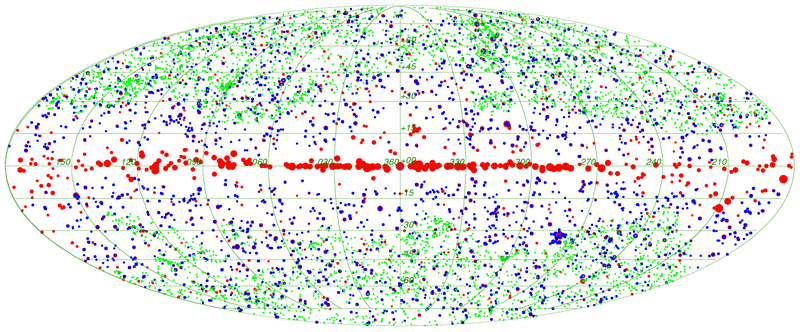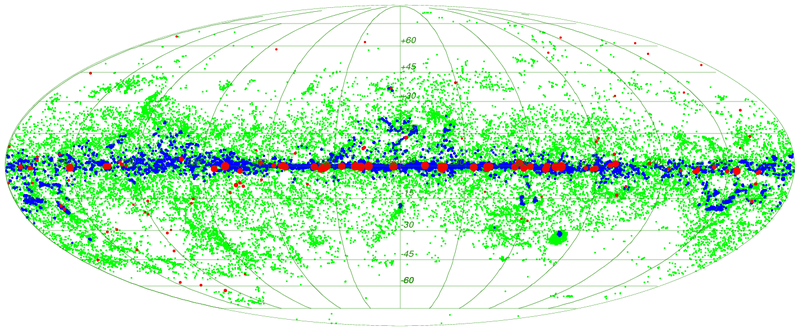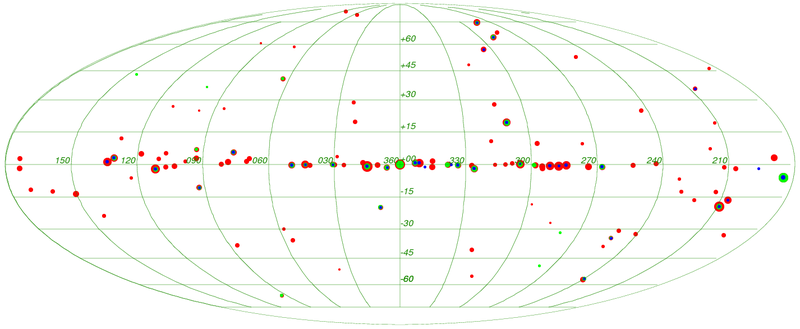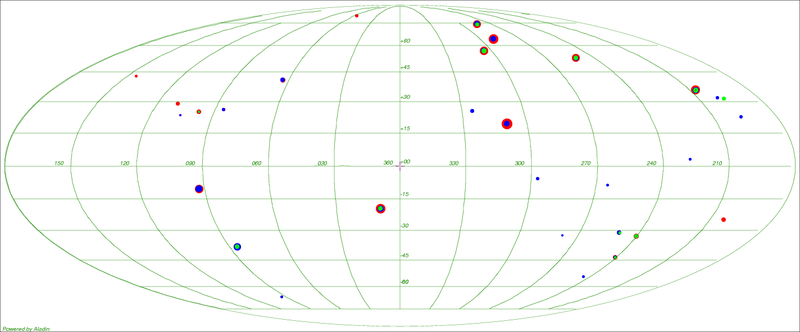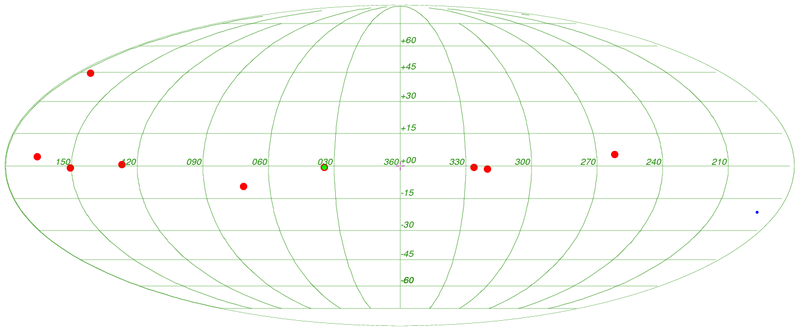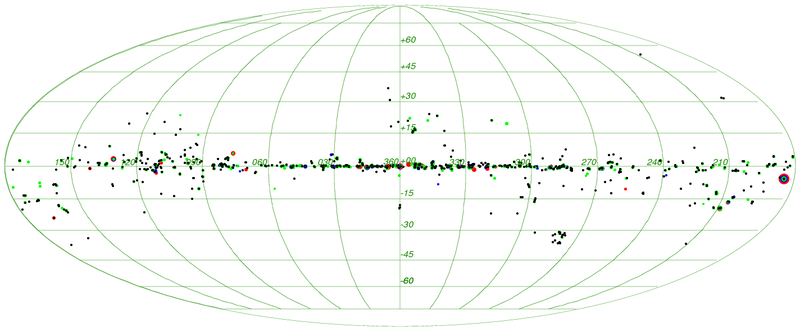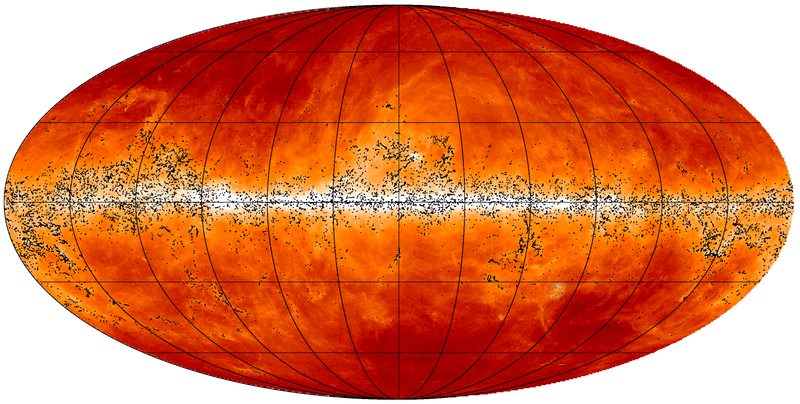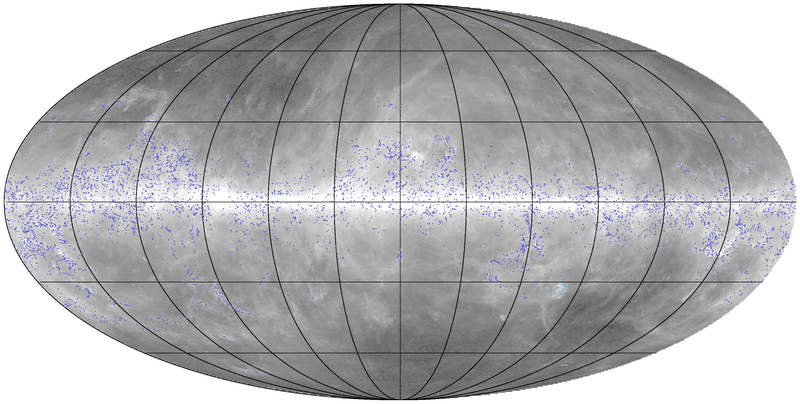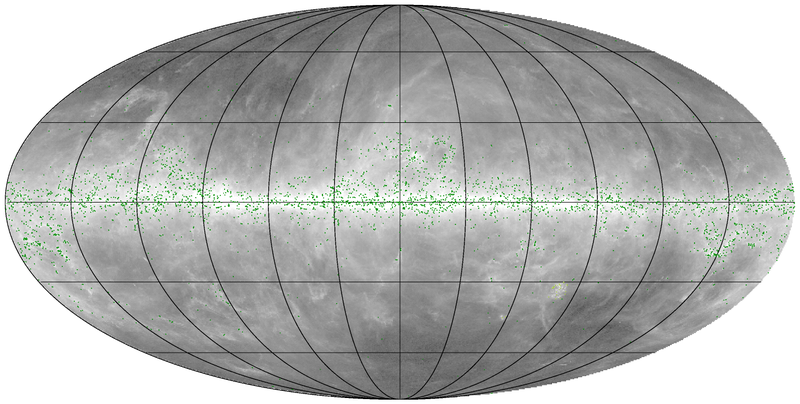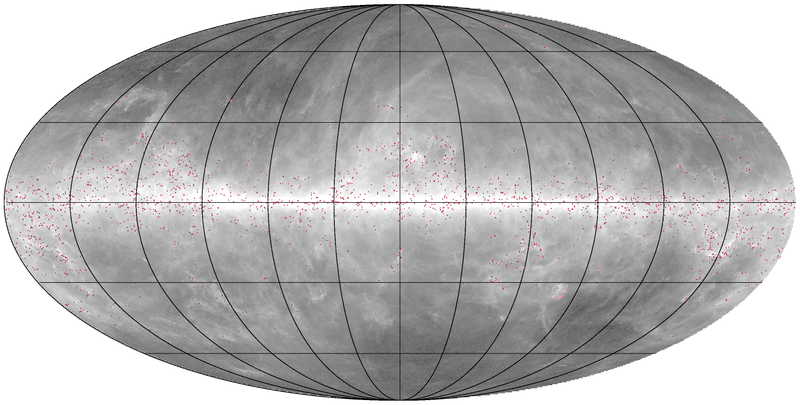Catalogues
Contents
Catalogue of Compact Sources[edit]
The second Planck Catalogue of Compact Sources (PCCS2) is a set of single-frequency source catalogues extracted from the Planck full-mission maps in intensity and polarization. The catalogues have been constructed as described in PCCS and in section 2 of Planck-2015-A26[1]. The validation of the catalogues is described in section 3 of Planck-2015-A26[1].
The PCCS2 is divided into two sub-catalogues in each frequency channel. The main PCCS2 catalogues consist of the sources detected in regions of the sky where it is possible to estimate the reliability of the detections, either statistically or by using external catalogues. Sources detected in regions of the sky where it is not possible to make an estimate of their reliability have been excluded from the main catalogue, but have been made available as the PCCS2E. By definition, the reliability of the PCCS2 is ≥ 80%, and a flag is available that allows the user to select a subsample of sources with a higher level of reliability (e.g., 90% or 95%).
The nine Planck full-mission frequency channel maps are used as input to the source detection pipelines. They contain 48 months of data for LFI channels and 29 months of data for HFI channels. Therefore the flux densities of sources obtained from the full-mission maps are the average of at least 8 observations for LFI channels or at least 4 observations for HFI channels. The relevant properties of the frequency maps and main parameters used to generate the catalogues are summarized in Tables 1 and 2.
Four different photometry methods have been used. For one of the methods, the native photometry from the Mexican hat wavelet detection algorithm, the analysis is performed on patches containing tangent plane projections of the map. For the other methods (aperture photometry, point spread function fitting, and Gaussian fitting), the analysis is performed directly on the full-sky maps.
The analysis in polarization has been performed in a non-blind fashion, looking at the position of the sources previously detected in intensity. As a result, polarization flux densities and polarization angles have been measured for hundreds of sources with a significance >99.99%. This high threshold in significance has been chosen to minimize the possibility of misinterpreting a peak of the polarized background as a source. This implies that, in general, most of the polarized sources are very bright, introducing an additional selection effect.
| Channel | 30 | 44 | 70 | 100 | 143 | 217 | 353 | 545 | 857 |
|---|---|---|---|---|---|---|---|---|---|
| Frequency [GHz] | 28.4 | 44.1 | 70.4 | 100.0 | 143.0 | 217.0 | 353.0 | 545.0 | 857.0 |
| Wavelength [μm] | 10561 | 6807 | 4260 | 3000 | 2098 | 1382 | 850 | 550 | 350 |
| Number of sources | |||||||||
| PCCS2 | 1435 | 830 | 1101 | 1742 | 2160 | 2135 | 1344 | 1694 | 4891 |
| PCCS2E | 125 | 104 | 195 | 2487 | 4139 | 16842 | 22665 | 31068 | 43290 |
| Union PCCS2+PCCS2E | 1560 | 934 | 1296 | 4229 | 6299 | 18977 | 24009 | 32762 | 48181 |
| Number of sources in the extragalactic zonea. | |||||||||
| PCCS2 | 723 | 346 | 441 | 1742 | 2160 | 2135 | 1344 | 1694 | 4891 |
| PCCS2E | 22 | 21 | 63 | 0 | 0 | 26 | 289 | 839 | 2097 |
| Union PCCS2+PCSS2E | 745 | 367 | 504 | 1742 | 2160 | 2161 | 1633 | 2533 | 6988 |
| Flux densities [mJy] in the extragalactic zonea . | |||||||||
| PCCS2 | |||||||||
| minimumb | 378 | 621 | 456 | 232 | 147 | 127 | 242 | 535 | 720 |
| 90% completeness | 427 | 692 | 501 | 269 | 177 | 152 | 304 | 555 | 791 |
| uncertainty | 78 | 127 | 92 | 55 | 35 | 29 | 55 | 105 | 168 |
| PCCS2E | |||||||||
| minimumb | 356 | 494 | 398 | — | — | 189 | 350 | 597 | 939 |
| 90% completeness | 468 | 708 | 501 | — | — | 144 | 311 | 557 | 927 |
| uncertainty | 86 | 134 | 95 | — | — | 35 | 73 | 144 | 278 |
Table 1 Notes
a 30-70 GHz: the extragalactic zone is given by |b| > 30°. 100-857 GHz: outside of galactic region where the reliability cannot be accurately assessed. Note that for the PCCS2E the only sources which occur in this region lie in the filament mask.
b Minimum flux density of the catalogue in the extragalactic zone after excluding the faintest 10% of sources.
| Channel | 30 | 44 | 70 | 100 | 143 | 217 | 353 |
|---|---|---|---|---|---|---|---|
| Number of significantly polarized sources in PCCS2 | 113 | 29 | 33 | 20 | 25 | 11 | 1 |
| Minimum polarized flux densitya [mJy] | 117 | 181 | 284 | 138 | 148 | 166 | 453 |
| Polarized flux density uncertainty [mJy] | 46 | 88 | 91 | 30 | 26 | 30 | 81 |
| Minimum polarized flux density completeness 90% [mJy] | 199 | 412 | 397 | 135 | 100 | 136 | 347 |
| Minimum polarized flux density completeness 95% [mJy] | 251 | 468 | 454 | 160 | 111 | 153 | 399 |
| Minimum polarized flux density completeness 100% [mJy] | 600 | 700 | 700 | 250 | 147 | 257 | 426 |
| Number of significantly polarized sources in PCCS2E | 9 | 1 | 1 | 43 | 111 | 325 | 666 |
| Minimum polarized flux densitya [mJy] | 101 | 2922 | 398 | 121 | 87 | 114 | 348 |
| Polarized flux density uncertainty [mJy] | 44 | 254 | 116 | 52 | 44 | 55 | 178 |
| Minimum polarized flux density completeness 90% [mJy] | — | — | — | 410 | 613 | 270 | 567 |
| Minimum polarized flux density completeness 95% [mJy] | — | — | — | 599 | 893 | 464 | 590 |
| Minimum polarized flux density completeness 100% [mJy] | — | — | — | 835 | 893 | 786 | 958 |
Table 2 Notes
a Minimum polarized flux density of the catalogue of significantly polarised sources after excluding the faintest 10% of sources.
Catalogues[edit]
The PCCS2 catalogues are contained in the FITS files:
- COM_PCCS_030_R2.02.fits
- COM_PCCS_044_R2.02.fits
- COM_PCCS_070_R2.02.fits
- COM_PCCS_100_R2.01.fits
- COM_PCCS_143_R2.01.fits
- COM_PCCS_217_R2.01.fits
- COM_PCCS_353_R2.01.fits
- COM_PCCS_545_R2.01.fits
- COM_PCCS_857_R2.01.fits
and the PCCS2E catalogues are contained in the FITS files:
- COM_PCCS_030-excluded_R2.02.fits
- COM_PCCS_044-excluded_R2.02.fits
- COM_PCCS_070-excluded_R2.02.fits
- COM_PCCS_100-excluded_R2.01.fits
- COM_PCCS_143-excluded_R2.01.fits
- COM_PCCS_217-excluded_R2.01.fits
- COM_PCCS_353-excluded_R2.01.fits
- COM_PCCS_545-excluded_R2.01.fits
- COM_PCCS_857-excluded_R2.01.fits
The structure of these files is as follows:
| Extension 0: Primary header, no data | |||
|---|---|---|---|
| FITS Keyword | Data Type | Units | Description |
| INSTRUME | String | Instrument (LFI / HFI) | |
| VERSION | String | Version of PCCS (PCCS2 / PCCS2_E) | |
| DATE | String | Date file created: yyyy-mm-dd | |
| ORIGIN | String | Name of organization responsible for the data (LFI-DPC / HFI-DPC) | |
| TELESCOP | String | Telescope (PLANCK) | |
| CREATOR | String | Pipeline Version | |
| DATE-OBS | String | days | Beginning of the survey: yyyy-mm-dd |
| DATE-END | String | days | End of the survey: yyyy-mm-dd |
| FWHM | Real*4 | arcmin | FWHM from an elliptical Gaussian fit to the effective beam |
| OMEGA_B | Real*4 | arcmin2 | Area of the effective beam |
| FWHM_EFF | Real*4 | arcmin | FWHM computed from OMEGA_B assuming beam is Gaussian |
| OMEGA_B1 | Real*4 | arcmin2 | Beam area within a radius of 1 × FWHM_EFF |
| OMEGA_B2 | Real*4 | arcmin2 | Beam area within a radius of 2 × FWHM_EFF |
| Extension 1: BINTABLE, EXTNAME = PCCS2_fff (where fff is the frequency channel) | |||
| Column Name | Data Type | Units | Description |
| Identification | |||
| NAME | String | Source name (see note 1) | |
| Source position | |||
| GLON | Real*8 | degrees | Galactic longitude based on extraction algorithm |
| GLAT | Real*8 | degrees | Galactic latitude based on extraction algorithm |
| RA | Real*8 | degrees | Right ascension (J2000) transformed from (GLON,GLAT) |
| DEC | Real*8 | degrees | Declination (J2000) transformed from (GLON,GLAT) |
| Photometry | |||
| DETFLUX | Real*4 | mJy | Flux density of source as determined by detection method |
| DETFLUX_ERR | Real*4 | mJy | Uncertainty (1 sigma) in derived flux density from detection method |
| APERFLUX | Real*4 | mJy | Flux density of source as determined from the aperture photometry |
| APERFLUX_ERR | Real*4 | mJy | Uncertainty (1 sigma) in derived flux density from the aperture photometry |
| PSFFLUX | Real*4 | mJy | Flux density of source as determined from PSF fitting |
| PSFFLUX_ERR | Real*4 | mJy | Uncertainty (1 sigma) in derived flux density from PSF fitting |
| GAUFLUX | Real*4 | mJy | Flux density of source as determined from 2-D Gaussian fitting |
| GAUFLUX_ERR | Real*4 | mJy | Uncertainty (1 sigma) in derived flux density from 2-D Gaussian fitting |
| GAU_SEMI1 | Real*4 | arcmin | Gaussian fit along axis 1 (FWHM; see note 2 for axis definition) |
| GAU_SEMI1_ERR | Real*4 | arcmin | Uncertainty (1 sigma) in derived Gaussian fit along axis 1 |
| GAU_SEMI2 | Real*4 | arcmin | Gaussian fit along axis 2 (FWHM) |
| GAU_SEMI2_ERR | Real*4 | arcmin | Uncertainty (1 sigma) in derived Gaussian fit along axis 2 |
| GAU_THETA | Real*4 | deg | Gaussian fit orientation angle (see note 2) |
| GAU_THETA_ERR | Real*4 | deg | Uncertainty (1 sigma) in derived gaussian fit orientation angle |
| GAU_FWHM_EFF | Real*4 | arcmin | Gaussian fit effective FWHM |
| Polarization measurements (30-353 GHz only) | |||
| P | Real*4 | mJy | Polarization flux density of the sources as determined by a matched filter (see note 3) |
| P_ERR | Real*4 | mJy | Uncertainty (1 sigma) in derived polarization flux density (see note 3) |
| ANGLE_P | Real*4 | degrees | Orientation of polarization with respect to NGP (see notes 2 and 3) |
| ANGLE_P_ERR | Real*4 | degrees | Uncertainty (1 sigma) in orientation of polarization (see note 3) |
| APER_P | Real*4 | mJy | Polarization flux density of the sources as determined by aperture photometry (see note 3) |
| APER_P_ERR | Real*4 | mJy | Uncertainty (1 sigma) in derived polarization flux density (see note 3) |
| APER_ANGLE_P | Real*4 | degrees | Orientation of polarization with respect to NGP (see notes 2 and 3) |
| APER_ANGLE_P_ERR | Real*4 | degrees | Uncertainty (1 sigma) in orientation of polarization (see note 3) |
| P_UPPER_LIMIT | Real*4 | mJy | Polarization flux density 99.99% upper limit. This is provided only when P column is set to NULL; otherwise this column itself contains a NULL. |
| APER_P_UPPER_LIMIT | Real*4 | mJy | Polarization flux density 99.99% upper limit. This is provided only when APER_P column is set to NULL; otherwise this column itself contains a NULL. |
| Marginal polarization measurements (100-353 GHz only) – see note 4 | |||
| P_STAT | Integer*2 | Polarization detection status | |
| PX | Real*4 | mJy | Polarization flux density of the sources as determined by a matched filter using Bayesian polarization estimator. |
| PX_ERR_LOWER | Real*4 | mJy | PX uncertainty; lower 95% error bar |
| PX_ERR_UPPER | Real*4 | mJy | PX uncertainty; upper 95% error bar |
| ANGLE_PX | Real*4 | degrees | Orientation of polarization with respect to NGP using Bayesian polarization estimator (see note 2) |
| ANGLE_PX_ERR_LOWER | Real*4 | degrees | ANGLE_PX uncertainty; lower 95% error bar |
| ANGLE_PX_ERR_UPPER | Real*4 | degrees | ANGLE_PX uncertainty; upper 95% error bar |
| Flags and validation | |||
| EXTENDED | Integer*2 | Extended source flag (see note 5) | |
| EXT_VAL | Integer*2 | External validation flag (see note 6) | |
| ERCSC | String | Name of the ERCSC counterpart, if any | |
| PCCS | String | Name of the PCCS counterpart, if any | |
| Flags and validation (PCCS2 only) | |||
| HIGHEST_RELIABILITY_CAT | Integer*4 | See note 7 | |
| Flags and validation (PCCS2E 100-857 GHz only) | |||
| WHICH_ZONE | Integer*2 | See note 8 | |
| Flags and validation (217-857 GHz only) | |||
| CIRRUS_N | Integer*2 | Number of sources (S/N > 5) detected at 857 GHz within a 1-degree radius. | |
| SKY_BRIGHTNESS | Real*4 | MJy/sr | The mean 857 GHz brightness within a 2-degree radius. This may be used as another indicator of cirrus contamination. |
| Flux densities at other frequencies (857 GHz only) | |||
| APERFLUX_217 | Real*4 | mJy | Estimated flux density at 217 GHz |
| APERFLUX_ERR_217 | Real*4 | mJy | Uncertainty in flux density at 217 GHz |
| APERFLUX_353 | Real*4 | mJy | Estimated flux density at 353 GHz |
| APERFLUX_ERR_353 | Real*4 | mJy | Uncertainty in flux density at 353 GHz |
| APERFLUX_545 | Real*4 | mJy | Estimated flux density at 545 GHz |
| APERFLUX_ERR_545 | Real*4 | mJy | Uncertainty in flux density at 545 GHz |
Notes
- Format is PCCS2 fff Glll.ll±bb.bb for sources in the PCCS2 and PCCS2E fff Glll.ll±bb.bb for sources in the PCCS2E, where fff is the frequency channel and (l, b) is the position of the source in Galactic coordinates truncated to two decimal places.
- We follow the IAU/IEEE convention (Hamaker & Bregman 1996) for defining the angle of polarization of a source, and this convention is also used for the other angles in the catalogue. The angle is measured from the North Galactic Pole in a clockwise direction from -90 to 90 degrees.
- Provided when the significance of the polarization measurement is > 99.99% and set to NULL otherwise.
- The P_STAT flag gives the status of the marginal polarization detection, possible values are:
- 3 – Bright: P field filled in; all PX fields set to NULL.
- 2 – Significant: P field is set to NULL; 0 is outside the PX 95% HPD; all PX fields are filled.
- 1 – Marginal: P field is set to NULL; 0 is inside the PX 95% HPD, but mode of PX posterior distribution is not 0; all PX fields are filled.
- 0 – No detection: P field is set to NULL; mode of PX posterior distribution is 0; PX_ERRL, ANGLE_PX, ANGLE_PX_ERR_LOWER, and ANGLE_PX_ERR_UPPER are set to NULL.
- The EXTENDED flag has the value of 0 if the source is compact and the value of 1 is it extended. The source size is determined by the geometric mean of the Gaussian fit FWHMs, with the criterion for extension being sqrt(GAU_FWHMMAJ * GAU_FWHMIN) > 1.5 times the beam FWHM.
- The EXT_VAL flag gives the status of the external validation, possible values are:
- 3 – The source has a clear counterpart in one of the catalogues used as ancillary data.
- 2 – The source does not have a clear counterpart in one of the catalogues used as ancillary data but it has been detected by the internal multi-frequency method.
- 1 – The source does not have a clear counterpart in one of the catalogues used as ancillary data and it has not been detected by the internal multi-frequency method, but it has been detected in a previous Planck source catalogue.
- 0 – The source does not have a clear counterpart in one of the catalogues used as ancillary data and it has not been detected by the internal multi-frequency method.
- The HIGHEST_RELIABILTY_CAT column contains the highest reliability catalogue to which the source belongs. As the full catalogue reliability is ≥ 80%, this is the lowest possible value in this column. Where possible this is provided in steps of 1% otherwise it is in steps of 5%.
- The WHICH_ZONE column encodes the zone in which the source lies:
- 1 – source lies inside filament mask.
- 2 – source lies inside Galactic zone.
- 3 – sources lies in both filament mask and Galactic zone.
Zone map[edit]
For each HFI frequency channel there is an associated map which defines the quantified-reliability (PCCS2) and unquantified-reliability (PCCS2E) zones are on the sky.
The files are called:
- COM_PCCS_100-zoneMask_R2.01.fits
- COM_PCCS_143-zoneMask_R2.01.fits
- COM_PCCS_217-zoneMask_R2.01.fits
- COM_PCCS_353-zoneMask_R2.01.fits
- COM_PCCS_545-zoneMask_R2.01.fits
- COM_PCCS_857-zoneMask_R2.01.fits
The structure of the files is as follows:
| Extension 0: Primary header, no data | |||
|---|---|---|---|
| FITS Keyword | Data Type | Units | Description |
| DATE | String | Date of creation of file | |
| Extension 1: BINTABLE, HEALPix map (see note 1) | |||
| FITS keyword | Data Type | Value | Description |
| PIXTYPE | String | HEALPIX | HEALPix pixelation |
| ORDERING | String | RING | Pixel ordering |
| NSIDE | Int*4 | 2048 | HEALPix resolution parameter |
| NPIX | Int*4 | 50331648 | Number of pixels |
| COORDSYS | String | G | Coordinate system |
| FREQ_CHL | String | Frequency channel | |
Notes
- This FITS extension contains an integer HEALPix map which encodes the information on which of 4 possible regions on the sky each pixel belongs to:
- 0 – quantified-reliability zone (PCCS2).
- 1 – filament mask.
- 2 – Galactic zone.
- 3 – filament mask and Galactic zone.
S/N threshold map[edit]
For each HFI frequency channel there are a number of maps which contains the S/N threshold used to accept sources into the PCCS2 and PCCS2E catalogues.
For the full catalogue (80% reliability in the quantified reliability zone) they are:
- COM_PCCS_100-SN-threshold_R2.01.fits
- COM_PCCS_143-SN-threshold_R2.01.fits
- COM_PCCS_217-SN-threshold_R2.01.fits
- COM_PCCS_353-SN-threshold_R2.01.fits
- COM_PCCS_545-SN-threshold_R2.01.fits
- COM_PCCS_857-SN-threshold_R2.01.fits
For 85% reliability they are:
- COM_PCCS_100-SN-threshold-85pc-reliability_R2.01.fits
- COM_PCCS_143-SN-threshold-85pc-reliability_R2.01.fits
- COM_PCCS_217-SN-threshold-85pc-reliability_R2.01.fits
- COM_PCCS_353-SN-threshold-85pc-reliability_R2.01.fits
- COM_PCCS_545-SN-threshold-85pc-reliability_R2.01.fits
- COM_PCCS_857-SN-threshold-85pc-reliability_R2.01.fits
For 90% reliability they are:
- COM_PCCS_100-SN-threshold-90pc-reliability_R2.01.fits
- COM_PCCS_143-SN-threshold-90pc-reliability_R2.01.fits
- COM_PCCS_217-SN-threshold-90pc-reliability_R2.01.fits
- COM_PCCS_353-SN-threshold-90pc-reliability_R2.01.fits
- COM_PCCS_545-SN-threshold-90pc-reliability_R2.01.fits
- COM_PCCS_857-SN-threshold-90pc-reliability_R2.01.fits
For 95% reliability they are:
- COM_PCCS_100-SN-threshold-95pc-reliability_R2.01.fits
- COM_PCCS_143-SN-threshold-95pc-reliability_R2.01.fits
- COM_PCCS_217-SN-threshold-95pc-reliability_R2.01.fits
- COM_PCCS_353-SN-threshold-95pc-reliability_R2.01.fits
- COM_PCCS_545-SN-threshold-95pc-reliability_R2.01.fits
- COM_PCCS_857-SN-threshold-95pc-reliability_R2.01.fits
The structure of the files is as follows:
| Extension 0: Primary header, no data | |||
|---|---|---|---|
| FITS Keyword | Data Type | Units | Description |
| DATE | String | Date of creation of file | |
| Extension 1: BINTABLE, HEALPix map (see note 1) | |||
| FITS keyword | Data Type | Value | Description |
| PIXTYPE | String | HEALPIX | HEALPix pixelation |
| ORDERING | String | RING | Pixel ordering |
| NSIDE | Int*4 | 2048 | HEALPix resolution parameter |
| NPIX | Int*4 | 50331648 | Number of pixels |
| COORDSYS | String | G | Coordinate system |
| FREQ_CHL | String | Frequency channel | |
Notes
- This FITS extension contains a single precision HEALPix map of the S/N threshold applied in the generation of the catalogue at that position on the sky.
Noise map[edit]
For each HFI frequency channel there is an associated map which contains the detection noise as a function of position on the sky.
The files are called:
- COM_PCCS_100-noise-level_R2.01.fits
- COM_PCCS_143-noise-level_R2.01.fits
- COM_PCCS_217-noise-level_R2.01.fits
- COM_PCCS_353-noise-level_R2.01.fits
- COM_PCCS_545-noise-level_R2.01.fits
- COM_PCCS_857-noise-level_R2.01.fits
The structure of the files is as follows:
| Extension 0: Primary header, no data | |||
|---|---|---|---|
| FITS Keyword | Data Type | Units | Description |
| DATE | String | Date of creation of file | |
| Extension 1: BINTABLE, HEALPix map (see note 1) | |||
| FITS keyword | Data Type | Value | Description |
| PIXTYPE | String | HEALPIX | HEALPix pixelation |
| ORDERING | String | RING | Pixel ordering |
| NSIDE | Int*4 | 2048 | HEALPix resolution parameter |
| NPIX | Int*4 | 50331648 | Number of pixels |
| COORDSYS | String | G | Coordinate system |
| FREQ_CHL | String | Frequency channel | |
Notes
- This FITS extension contains a single precision HEALPix map of the detection noise at each location on the sky, in units of Jy.
SZ Catalogue[edit]
The Planck SZ catalogue is constructed as described in SZ catalogue and in sections 2 and 3 of Planck-2015-A27[2]. Three pipelines are used to detect SZ clusters: two independent implementations of the Matched Multi-Filter (MMF1 and MMF3), and PowellSnakes (PwS). The main catalogue is constructed as the union of the catalogues from the three detection methods. The completeness and reliability of the catalogues have been assessed through internal and external validation as described in section 4 of Planck-2015-A27[2].
The size of a detection is given in terms of the scale size, θs, and the flux is given in terms of the total integrated Comptonization parameter, Y = Y5R500. The parameters of the GNFW profile assumed by the detection pipelines are written in the headers of the catalogues. For the sake of convenience, the conversion factor from Y to Y500 is also provided in the header.
The union catalogue contains the coordinates of a detection, its signal-to-noise ratio, an estimate of Y and its uncertainty, together with a summary of the validation information, including external identification of a cluster and its redshift if they are available. The pipeline from which the information is taken is called the reference pipeline. If more than one pipeline makes the same detection, the information is taken from the the pipeline that makes the most significant detection. Where the redshift is known, we provide the SZ mass for the reference pipeline.
The individual catalogues contain the coordinates and the signal-to-noise ratio of the detections, and information on the size and flux of the detections. The entries are cross-referenced to the detections in the union catalogue. The full information on the degeneracy between θs and Y is included in the individual catalogues in the form of the two-dimensional probability distribution for each detection. It is computed on a well-sampled grid to produce a two-dimensional image for each detection. It is provided in this form so it can be combined with a model or external data to produce tighter constraints on the parameters. The individual catalogues also contain Planck measurements of the SZ mass observable, MSZ, as calculated using a Y-M scaling relation and an assumed redshift to break the Y-θs degeneracy. These are provided for each detection as functions of assumed redshift, in the range 0.01 < z < 1, along with the upper and lower 68% confidence limits.
The selection function of the union catalogue, the intersection catalogue and the individual catalogues are provided in additional files. The selection function files contains the probability of detection for clusters of given intrinsic parameters θ500 and Y500. The file includes the definition of the survey area in the form of a HEALPix mask, and is evaluated for a range of signal-to-noise thresholds between 4.5 and 10.
Union catalogue[edit]
The union catalogue is contained in HFI_PCCS_SZ-union_R2.08.fits.
| Extension 0: Primary header, no data | |||
|---|---|---|---|
| FITS Keyword | Data Type | Units | Description |
| INSTRUME | String | Instrument (HFI) | |
| VERSION | String | Version of catalogue | |
| DATE | String | Date file created: yyyy-mm-dd | |
| ORIGIN | String | Name of organization responsible for the data (HFI-DPC) | |
| TELESCOP | String | Telescope (PLANCK) | |
| CREATOR | String | Pipeline version | |
| DATE-OBS | String | Start date of the survey: yyyy-mm-dd | |
| DATE-END | String | End date of the survey: yyyy-mm-dd | |
| PROCVER | String | Data version | |
| PP_ALPHA | Real*4 | GNFW pressure profile α parameter | |
| PP_BETA | Real*4 | GNFW pressure profile β parameter | |
| PP_GAMMA | Real*4 | GNFW pressure profile γ parameter | |
| PP_C500 | Real*4 | GNFW pressure profile c500 parameter | |
| PP_Y2YFH | Real*4 | Conversion factor from Y to Y500 | |
| Extension 1: BINTABLE, EXTNAME = PSZ2_UNION | |||
| Column Name | Data Type | Units | Description |
| INDEX | Int*4 | Index used to cross-reference with individual catalogues | |
| NAME | String | Source name (see note 1) | |
| GLON | Real*8 | degrees | Galactic longitude |
| GLAT | Real*8 | degrees | Galactic latitude |
| RA | Real*8 | degrees | Right ascension (J2000) transformed from (GLON,GLAT) |
| DEC | Real*8 | degrees | Declination (J2000) transformed from (GLON,GLAT) |
| POS_ERR | Real*4 | arcmin | Position uncertainty (95% confidence interval) |
| SNR | Real*4 | Signal-to-noise ratio of the detection | |
| PIPELINE | Int*4 | Pipeline from which information is taken (reference pipeline): 1= MMF1; 2 = MMF3; 3 = PwS | |
| PIPE_DET | Int*4 | Pipelines which detect this object (see note 2) | |
| PCCS2 | Bool | Indicates whether detection matches with any in PCCS2 catalogues | |
| PSZ | Int*4 | Index of matching detection in PSZ1, or -1 if new detection | |
| IR_FLAG | Int*1 | Flag denoting heavy infrared contamination | |
| Q_NEURAL | Real*4 | Neural network quality flag (see note 3) | |
| Y5R500 | Real*4 | 10-3 arcmin2 | Mean marginal Y5R500 as determined by reference pipeline |
| Y5R500_ERR | Real*4 | 10-3 arcmin2 | Uncertainty on Y5R500 as determined by reference pipeline |
| VALIDATION | Int*4 | External validation status (see note 4) | |
| REDSHIFT_ID | String | External identifier of cluster associated with redshift measurement (see note 5) | |
| REDSHIFT | Real*4 | Redshift of cluster (see note 5) | |
| MSZ | Real*4 | 1014 Msol | SZ mass proxy (see note 6) |
| MSZ_ERR_UP | Real*4 | 1014 Msol | Upper bound of 68% SZ mass proxy confidence interval (see note 6) |
| MSZ_ERR_LOW | Real*4 | 1014 Msol | Lower bound of 68% SZ mass proxy confidence interval (see note 6) |
| MCXC | String | Identifier of X-ray counterpart in the MCXC, if one is present | |
| REDMAPPER | String | Identifier of optical counterpart in the RedMAPPer catalogue, if one is present | |
| ACT | String | Identifier of SZ counterpart in the ACT catalogues, if one is present | |
| SPT | String | Identifier of SZ counterpart in the SPT catalogues, if one is present | |
| WISE_FLAG | Int*4 | Confirmation flag of WISE overdensity (see note 7) | |
| AMI_EVIDENCE | Real*4 | Bayesian evidence for AMI counterpart detection (see note 8) | |
| COSMO | Bool | Indicates whether detection is in the cosmology sample | |
| COMMENT | String | Comments on this detection | |
Notes
- Format is PSZ2 Glll.ll±bb.b where (l,b) are the Galactic coordinates truncated to 2 decimal places.
- The three least significant decimal digits are used to represent detection or non-detection by the pipelines. Order of the digits: hundreds = MMF1; tens = MMF3; units = PwS. If it is detected then the corresponding digit is set to 1, otherwise it is set to 0.
- Neural network quality flag is 1-Qbad, following the definitions in Aghanim et al. 2014.
- Summary of the external validation, encoding the most robust external identification: 10 = ENO follow-up; 11 = RTT follow-up; 12 = PanSTARRs; 13 = RedMAPPer non-blind; 14 = SDSS high-z; 15 = AMI; 16 = WISE; 20 = legacy identification from the PSZ1; 21 = MCXC; 22 = SPT; 23 = ACT; 24 = RedMAPPer; 25 = legacy identification from PSZ1 with externally updated redshift; 30 = NED; -1 = no known external counterpart.
- Redshift source is the most robust external identification listed in the VALIDATION field.
- MSZ is the hydrostatic mass assuming the best-fit Y-M scaling relation of Arnaud 2010 as a prior. The uncertainties are statistical and based on the Planck measurement uncertainties only. Not included in the uncertainties are the statistical errors on the scaling relation, the intrinsic scatter in the relation, or systematic errors in data selection for the scaling relation fit.
- Assigned by visual inspection: 0 = no significant galaxy overdensity; 1 = possible galaxy overdensity; 2 = probable galaxy overdensity; 3 = significant galaxy overdensity detected; -1 = possible galaxy overdensity (affected by bright star artefacts); -2 = no significant galaxy overdensity (affected by bright star artefacts); -3 = no assessment possible (affected by bright star artefacts); -10 = not analysed.
- Defined in the paper.
Individual catalogues[edit]
The individual pipeline catalogues are contained in the FITS files
- HFI_PCCS_SZ-MMF1_R2.08.fits (MMF1 pipeline)
- HFI_PCCS_SZ-MMF3_R2.08.fits (MMF3 pipeline)
- HFI_PCCS_SZ-PwS_R2.08.fits (PowellSnakes pipeline)
Their structure is as follows:
| Extension 0: Primary header, no data | |||
|---|---|---|---|
| FITS Keyword | Data Type | Units | Description |
| INSTRUME | String | Instrument (HFI) | |
| VERSION | String | Version of catalogue | |
| DATE | String | Date file created: yyyy-mm-dd | |
| ORIGIN | String | Name of organization responsible for the data (HFI-DPC) | |
| TELESCOP | String | Telescope (PLANCK) | |
| CREATOR | String | Pipeline version | |
| DATE-OBS | String | Start time of the survey: yyyy-mm-dd | |
| DATE-END | String | End time of the survey: yyyy-mm-dd | |
| PROCVER | String | Data version | |
| PP_ALPHA | Real*4 | GNFW pressure profile α parameter | |
| PP_BETA | Real*4 | GNFW pressure profile β parameter | |
| PP_GAMMA | Real*4 | GNFW pressure profile γ parameter | |
| PP_C500 | Real*4 | GNFW pressure profile c500 parameter | |
| PP_Y2YFH | Real*4 | Conversion factor from Y to Y500 | |
| Extension 1: BINTABLE, EXTNAME = PSZ2_INDIVIDUAL | |||
| Column Name | Data Type | Units | Description |
| INDEX | Int*4 | Index from union catalogue | |
| NAME | String | Source name (see note 1) | |
| GLON | Real*8 | degrees | Galactic longitude |
| GLAT | Real*8 | degrees | Galactic latitude |
| RA | Real*8 | degrees | Right ascension (J2000) transformed from (GLON, GLAT) |
| DEC | Real*8 | degrees | Declination (J2000) transformed from (GLON, GLAT) |
| POS_ERR | Real*4 | arcmin | Position uncertainty (95% confidence interval) |
| SNR | Real*4 | Signal-to-noise ratio of detection | |
| TS_MIN | Real*4 | Minimum value of θs in grid in second extension HDU (see note 2) | |
| TS_MAX | Real*4 | Maximum value of θs in grid in second extension HDU (see note 2) | |
| Y_MIN | Real*4 | Minimum value of Y in grid in second extension HDU (see note 2) | |
| Y_MAX | Real*4 | Maximum value of Y in grid in second extension HDU (see note 2) | |
| Keyword | Data Type | Value | Description |
| PIPELINE | String | Name of detection pipeline | |
| Extension 2: IMAGE, EXTNAME = PSZ2_PROBABILITY (see note 2) | |||
| Keyword | Data Type | Value | Description |
| NAXIS1 | Integer | 256 | Dimension 1 |
| NAXIS2 | Integer | 256 | Dimension 2 |
| NAXIS3 | Integer | Ndet | Dimension 3 = Number of detections |
| Keyword | Data Type | Value | Description |
| PIPELINE | String | Name of detection pipeline | |
| Extension 3: IMAGE, EXTNAME = PSZ2_MSZ_ARRAY (see note 3) | |||
| Keyword | Data Type | Value | Description |
| NAXIS1 | Integer | 100 | Dimension 1 |
| NAXIS2 | Integer | 4 | Dimension 2 |
| NAXIS3 | Integer | Ndet | Dimension 3 = Number of detections |
| Keyword | Data Type | Value | Description |
| PIPELINE | String | Name of detection pipeline | |
Notes
- Format PSZ2 Glll.ll±bb.bb where (l, b) are the Galactic coordinates truncated to 2 decimal places.
- Extension 2 contains a three-dimensional image with the two-dimensional probability distribution in θs and Y for each detection. The probability distributions are evaluated on a 256 × 256 linear grid between the limits specified in extension 1. The limits are determined independently for each detection. The dimension of the 3D image is 256 × 256 × Ndet, where Ndet is the number of detections. The first dimension is θs and the second dimension is Y.
- Extension 3 contains a three-dimensional image with the information on the MSZ observable per cluster as a function of assumed redshift. The image dimensions are 100 × 4 × Ndet, where Ndet is the number of detections. The first dimension is the assumed redshift. The second dimension has size 4: the first element is the assumed redshift value corresponding to the MSZ values. The second element is the MSZ lower 68% confidence bound, the third element is the MSZ estimate and the fourth element is the MSZ upper 68% confidence bound, all in units of 1014 Msol. These uncertainties are based on the Planck measurement uncertainties only. Not included in the error estimates are the statistical errors on the scaling relation, the intrinsic scatter in the relation, or systematic errors in data selection for the scaling relation fit.
Selection function[edit]
The selection function for the union, intersection and individual pipeline catalogues are contained in the FITS files:
- HFI_PCCS_SZ-selfunc-union-survey_R2.08.fits (union catalogue, survey mask)
- HFI_PCCS_SZ-selfunc-union-cosmology_R2.08.fits (union catalogue, cosmology mask)
- HFI_PCCS_SZ-selfunc-intersec-survey_R2.08.fits (intersection catalogue, survey mask)
- HFI_PCCS_SZ-selfunc-intersec-cosmolog_R2.08.fits (intersection catalogue, cosmology mask)
- HFI_PCCS_SZ-selfunc-MMF1-survey_R2.08.fits (MMF1 catalogue, survey mask)
- HFI_PCCS_SZ-selfunc-MMF1-cosmolog_R2.08.fits (MMF1 catalogue, cosmology mask)
- HFI_PCCS_SZ-selfunc-MMF3-survey_R2.08.fits (MMF3 catalogue, survey mask)
- HFI_PCCS_SZ-selfunc-MMF3-cosmolog_R2.08.fits (MMF3 catalogue, cosmology mask)
- HFI_PCCS_SZ-selfunc-PwS-survey_R2.08.fits (PowellSnakes catalogue, survey mask)
- HFI_PCCS_SZ-selfunc-PwS-cosmolog_R2.08.fits (PowellSnakes catalogue, cosmology mask)
Their structure is as follows:
| Extension 0: Primary header, no data | |||
|---|---|---|---|
| FITS Keyword | Data Type | Units | Description |
| INSTRUME | String | Instrument (HFI) | |
| VERSION | String | Version of catalogue | |
| DATE | String | Date file created: yyyy-mm-dd | |
| ORIGIN | String | Name of organization responsible for the data (HFI-DPC) | |
| TELESCOP | String | Telescope (PLANCK) | |
| CREATOR | String | Pipeline version | |
| DATE-OBS | String | Start time of the survey: yyyy-mm-dd | |
| DATE-END | String | End time of the survey: yyyy-mm-dd | |
| PROCVER | String | Data version | |
| JOIN | String | Join type (UNION, INTERSEC, MMF1, MMF3, PwS) | |
| MASK | String | Mask name (SURVEY, COSMOLOG) | |
| Extension 1: BINTABLE, HEALPix map (see note 1) | |||
| FITS keyword | Data Type | Value | Description |
| PIXTYPE | String | HEALPIX | HEALPix pixelation |
| ORDERING | String | RING | Pixel ordering |
| NSIDE | Int*4 | 2048 | HEALPix resolution parameter |
| NPIX | Int*4 | 50331648 | Number of pixels |
| COORDSYS | String | G | Coordinate system |
| Extension 2: IMAGE, EXTNAME = SELFUNC (see note 2) | |||
| Keyword | Data Type | Value | Description |
| NAXIS1 | Integer | 30 | Dimension 1 |
| NAXIS2 | Integer | 32 | Dimension 2 |
| NAXIS3 | Integer | 12 | Dimension 3 |
| Keyword | Data Type | Value | Description |
| AXIS1 | String | CY500 | Name of axis 1 |
| AXIS2 | String | T500 | Name of axis 2 |
| AXIS3 | String | SNRCUT | Name of axis 3 |
| UNITS | String | PERCENT | Units of selection function |
| COMPTYPE | String | DIFF | Type of selection function (differential) |
| Extension 3: IMAGE, EXTNAME = YGRID (see note 3) | |||
| Keyword | Data Type | Value | Description |
| NAXIS1 | Integer | 30 | Dimension 1 |
| Keyword | Data Type | Value | Description |
| COL1 | String | CY500 | Grid values of Y500 |
| Extension 4: IMAGE, EXTNAME = TGRID (see note 4) | |||
| Keyword | Data Type | Value | Description |
| NAXIS1 | Integer | 32 | Dimension 1 |
| Keyword | Data Type | Value | Description |
| COL1 | String | T500 | Grid values of θ500 |
| Extension 5: IMAGE, EXTNAME = SNR_THRESH (see note 5) | |||
| Keyword | Data Type | Value | Description |
| NAXIS1 | Integer | 12 | Dimension 1 |
| Keyword | Data Type | Value | Description |
| COL1 | String | S/N | Grid values of S/N threshold |
Notes
- Extension 1 contains a mask defining the survey region, given by an Nside = 2048 ring-ordered HEALPix map in GALACTIC coordinates. Pixels in the survey region have the value 1.0 while pixels outside of the survey region have value 0.0.
- Extension 2 contains a three-dimensional image containing the survey completeness probability distribution for various S/N thresholds. The information is stored in an image of size 30 × 32 × 12. The first dimension is Y500, the second dimension is θ500 and the third dimension is the signal-to-noise threshold. The units are percent and lie in the range 0-100 and denote the detection probability of a cluster in the given (Y500, θ500) bin.
- Extension 3 contains the Y500 grid values for the completeness data cube in the second extension. It has length 30 and spans the range from 1.12480 × 10-4 arcmin2 to 7.20325 × 10-2 arcmin2 in logarithmic steps.
- Extension 4 contains the θ500 grid values for the completeness data cube in the second extension. It has length 32 and spans the range from 0.9416 arcmin to 35.31 arcmin in logarithmic steps.
- Extension 5 contains the signal-to-noise threshold grid values for the completeness data cube in the second extension. It has length 12 and contains thresholds from 4.5 to 10.0 in steps of 0.5.
Galactic Cold Clumps Catalogue[edit]
The Planck Galactic Cold Clumps Catalogue (PGCC) is a list of 13188 Galactic sources and 54 sources located in the Small and Large Magellanic Clouds. The sources have been identified in Planck data as sources colder than their environment. It has been buit using the 48 months Planck data at 857, 545, and 353 GHz combined with the 3 THz IRIS data, as it is described in Planck-2015-A28[3].
The all-sky distribution of the PGCC sources is shown below on top of the 857 GHz emission shown in logarithmic scale between 10-2 to 102 MJy/sr.
Sources are divided into three categories based on the reliability of the flux density estimates in IRIS 3 THz and Planck 857, 545, and 353 GHz bands.
- FLUX_QUALITY=1 : sources with S/N > 1 in all bands ;
- FLUX_QUALITY=2 : sources with S/N > 1 only in 857, 545, and 353 GHz Planck bands, considered as very cold source candidates ;
- FLUX_QUALITY=3 : sources without any reliable flux density estimates, listed as poor candidates.
The all-sky distributions of the PGCC sources per FLUX_QUALITY category are shown below on top of the 857 GHz map in grey scale shown in logarithmic scale between 10-2 to 102 MJy/sr.
Distance estimates have been obtained on 5574 PGCC sources using seven different methods/technics, as described in Planck-2015-A28[3]. A flag is raised to quantify the quality of the distance estimates, defined as follows:
- DIST_QUALITY=0 : No distance estimate ;
- DIST_QUALITY=1 : Single distance estimate ;
- DIST_QUALITY=2 : Multiple distance estimates which are consistent within 1 ;
- DIST_QUALITY=3 : Multiple distance estimates which are not consistent within 1 ;
- DIST_QUALITY=4 : Single upper limits.
The all-sky distribution of the sources with robust distance estimates is shown below.
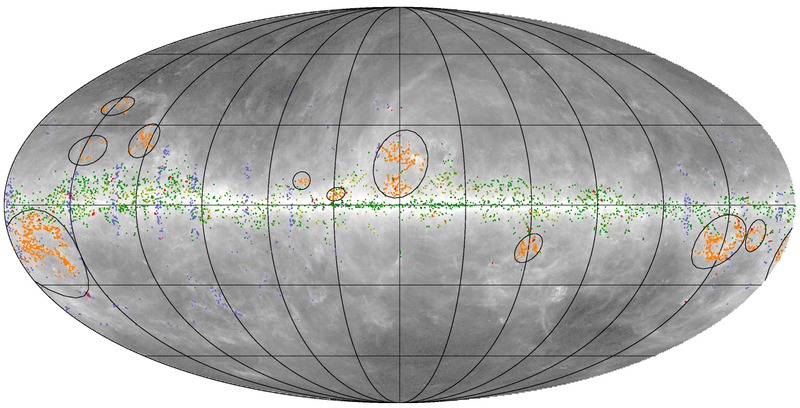
The catalogue is contained in the FITS file HFI_PCCS_GCC_R2.02.fits. It structure is as follows:
| Identification | |||
|---|---|---|---|
| FITS Keyword | Data Type | Units | Description |
| NAME | String | Source Name | |
| SNR | real*8 | Maximum S/N over the 857, 545, and 353 GHz Planck cold residual maps | |
| SNR_857 | real*8 | S/N of the cold residual detection at 857 GHz | |
| SNR_545 | real*8 | S/N of the cold residual detection at 545 GHz | |
| SNR_353 | real*8 | S/N of the cold residual detection at 353 GHz | |
| Source position | |||
| FITS Keyword | Data Type | Units | Description |
| GLON | real*8 | deg | Galactic longitude based on morphology fitting |
| GLAT | real*8 | deg | Galactic latitude based on morphology fitting |
| RA | real*8 | deg | Right ascension (J2000) in degrees transformed from (GLON, GLAT) |
| DEC | real*8 | deg | Declination (J2000) in degrees transformed from (GLON, GLAT) |
| Morphology | |||
| FITS Keyword | Data Type | Units | Description |
| GAU_MAJOR_AXIS | real*8 | arcmin | FWHM along the major axis of the elliptical Gaussian |
| GAU_MAJOR_AXIS_SIG | real*8 | arcmin | 1 uncertainty on the FWHM along the major axis |
| GAU_MINOR_AXIS | real*8 | arcmin | FWHM along the minor axis of the elliptical Gaussian |
| GAU_MINOR_AXIS_SIG | real*8 | arcmin | 1 uncertainty on the FWHM along the minor axis |
| GAU_POSITION_ANGLE | real*8 | rad | Position angle of the elliptical gaussian, defined as the angle between the axis parallele to the Galactic plane and the major axis, counted clockwise. |
| GAU_POSITION_ANGLE_SIG | real*8 | rad | 1 uncertainty on the position angle |
| Photometry | |||
| FITS Keyword | Data Type | Units | Description |
| FLUX_3000_CLUMP | real*8 | Jy | Flux density of the clump at 3 THz |
| FLUX_3000_CLUMP_SIG | real*8 | Jy | 1 uncertainty on the flux density of the clump at 3 THz |
| FLUX_857_CLUMP | real*8 | Jy | Flux density of the clump at 857 GHz |
| FLUX_857_CLUMP_SIG | real*8 | Jy | 1 uncertainty on the flux density of the clump at 857 GHz |
| FLUX_545_CLUMP | real*8 | Jy | Flux density of the clump at 545 GHz |
| FLUX_545_CLUMP_SIG | real*8 | Jy | 1 uncertainty on the flux density of the clump at 545 GHz |
| FLUX_353_CLUMP | real*8 | Jy | Flux density of the clump at 353 GHz |
| FLUX_353_CLUMP_SIG | real*8 | Jy | 1 uncertainty on the flux density of the clump at 353 GHz |
| FLUX_3000_WBKG | real*8 | Jy | Flux density of the warm background at 3 THz |
| FLUX_3000_WBKG_SIG | real*8 | Jy | 1 uncertainty on the flux density of warm background at 3 THz |
| FLUX_857_WBKG | real*8 | Jy | Flux density of the warm background at 857 GHz |
| FLUX_857_WBKG_SIG | real*8 | Jy | 1 uncertainty on the flux density of the warm background at 857 GHz |
| FLUX_545_WBKG | real*8 | Jy | Flux density of the warm background at 545 GHz |
| FLUX_545_WBKG_SIG | real*8 | Jy | 1 uncertainty on the flux density of the warm background at 545 GHz |
| FLUX_353_WBKG | real*8 | Jy | Flux density of the warm background at 353 GHz |
| FLUX_353_WBKG_SIG | real*8 | Jy | 1 uncertainty on the flux density of the warm background at 353 GHz |
| FLUX_QUALITY | int*4 | 1-3 | Category of flux density reliability |
| FLUX_BLENDING | int*4 | 0/1 | 1 if blending issue with flux density estimate |
| FLUX_BLENDING_IDX | int*8 | Catalogue index of the closest source responsible for blending | |
| FLUX_BLENDING_ANG_DIST | real*8 | arcmin | Angular distance to the closest source responsible for blending |
| FLUX_BLENDING_BIAS_3000 | real*8 | % | Relative bias of the flux density at 3000 GHz due to blending |
| FLUX_BLENDING_BIAS_857 | real*8 | % | Relative bias of the flux density at 857 GHz due to blending |
| FLUX_BLENDING_BIAS_545 | real*8 | % | Relative bias of the flux density at 545 GHz due to blending |
| FLUX_BLENDING_BIAS_353 | real*8 | % | Relative bias of the flux density at 353 GHz due to blending |
| Distance | |||
| FITS Keyword | Data Type | Units | Description |
| DIST_KINEMATIC | real*8 | kpc | Distance estimate [1] using kinematics |
| DIST_KINEMATIC_SIG | real*8 | kpc | 1 uncertainty on the distance estimate [1] using kinematics |
| DIST_OPT_EXT_DR7 | real*8 | kpc | Distance estimate [2] using optical extinction on SDSS DR7 |
| DIST_OPT_EXT_DR7_SIG | real*8 | kpc | 1 uncertainty on the distance estimate [2] using optical extinction on SDSS DR7 |
| DIST_OPT_EXT_DR9 | real*8 | kpc | Distance estimate [3] using optical extinction on SDSS DR9 |
| DIST_OPT_EXT_DR9_SIG | real*8 | kpc | 1 uncertainty on the distance estimate [3] using optical extinction on SDSS DR9 |
| DIST_NIR_EXT_IRDC | real*8 | kpc | Distance estimate [4] using near-infrared extinction towards IRDCs |
| DIST_NIR_EXT_IRDC_SIG | real*8 | kpc | 1 uncertainty on the distance estimate [4] using near-infrared extinction towards IRDCs |
| DIST_NIR_EXT | real*8 | kpc | Distance estimate [5] using near-infrared extinction |
| DIST_NIR_EXT_SIG | real*8 | kpc | 1 uncertainty on the distance estimate [5] using near-infrared extinction |
| DIST_MOLECULAR_COMPLEX | real*8 | kpc | Distance estimate [6] using molecular complex association |
| DIST_MOLECULAR_COMPLEX_SIG | real*8 | kpc | 1 uncertainty on the distance estimate [6] using molecular complex association |
| DIST_HKP_GCC | real*8 | kpc | Distance estimate [7] from the Herschel Key-Programme Galactic Cold Cores |
| DIST_HKP_GCC_SIG | real*8 | kpc | 1 uncertainty on the distance estimate [7] from the Herschel Key-Programme Galactic Cold Cores |
| DIST_OPTION | int*4 | 0-7 | Option of the best distance estimate used in other physical properties |
| DIST_QUALITY | int*4 | 0-4 | Quality Flag of the consistency between distance estimates |
| DIST | real*8 | kpc | Best distance estimate used for further physical properties |
| DIST_SIG | real*8 | kpc | 1 uncertainty on the best distance estimate |
| Temperature | |||
| FITS Keyword | Data Type | Units | Description |
| TEMP_CLUMP | real*8 | K | Temperature of the clump with as a free parameter |
| TEMP_CLUMP_SIG | real*8 | K | 1 uncertainty on the clump temperature with free |
| TEMP_CLUMP_LOW1 | real*8 | K | Lower 68% confidence limit of the clump temperature with free |
| TEMP_CLUMP_UP1 | real*8 | K | Upper 68% confidence limit of the clump temperature with free |
| BETA_CLUMP | real*8 | Spectral index of the clump | |
| BETA_CLUMP_SIG | real*8 | 1 uncertainty (from MCMC) on the emissivity spectral index of the clump | |
| BETA_CLUMP_LOW1 | real*8 | Lower 68% confidence limit of the emissivity spectral index of the clump | |
| BETA_CLUMP_UP1 | real*8 | Upper 68% confidence limit of the emissivity spectral index of the clump | |
| TEMP_BETA2_CLUMP | real*8 | K | Temperature of the clump with = 2 |
| TEMP_BETA2_CLUMP_SIG | real*8 | K | 1 uncertainty on the temperature of the clump with = 2 |
| TEMP_BETA2_CLUMP_LOW1 | real*8 | K | Lower 68% confidence limit of the clump temperature with = 2 |
| TEMP_BETA2_CLUMP_UP1 | real*8 | K | Upper 68% confidence limit of the clump temperature with = 2 |
| TEMP_WBKG | real*8 | K | Temperature of the warm background with as a free parameter |
| TEMP_WBKG_SIG | real*8 | K | 1 dispersion of the warm background temperature with free |
| TEMP_WBKG_LOW1 | real*8 | K | Lower 68% confidence limit of the warm background temperature with free |
| TEMP_WBKG_UP1 | real*8 | K | Upper 68% confidence limit of the warm background temperature with free |
| BETA_WBKG | real*8 | Spectral index of the warm background | |
| BETA_WBKG_SIG | real*8 | 1 uncertainty (from MCMC) of the emissivity spectral index of the warm background | |
| BETA_WBKG_LOW1 | real*8 | Lower 68% confidence limit of the emissivity spectral index of the warm background | |
| BETA_WBKG_UP1 | real*8 | Upper 68% confidence limit of the emissivity spectral index of the warm background | |
| TEMP_BETA2_WBKG | real*8 | K | Temperature of the warm background with = 2 |
| TEMP_BETA2_WBKG_SIG | real*8 | K | 1 uncertainty on the temperature of the warm background with = 2 |
| TEMP_BETA2_WBKG_LOW1 | real*8 | K | Lower 68% confidence limit of the warm background temperature with = 2 |
| TEMP_BETA2_WBKG_UP1 | real*8 | K | Upper 68% confidence limit of the warm background temperature with = 2 |
| Physical properties | |||
| FITS Keyword | Data Type | Units | Description |
| NH2 | real*8 | cm-2 | Column density of the clump |
| NH2_SIG | real*8 | cm-2 | 1 uncertainty on the column density |
| NH2_LOW[1,2,3] | real*8 | cm-2 | Lower 68%, 95% and 99% confidence limit of the column density |
| NH2_UP[1,2,3] | real*8 | cm-2 | Upper 68%, 95% and 99% confidence limit of the column density |
| MASS | real*8 | Mass estimate of the clump | |
| MASS_SIG | real*8 | 1 uncertainty on the mass estimate of the clump | |
| MASS_LOW[1,2,3] | real*8 | Lower 68%, 95% and 99% confidence limit of the mass estimate | |
| MASS_UP[1,2,3] | real*8 | Upper 68%, 95% and 99% confidence limit of the mass estimate | |
| DENSITY | real*8 | cm-3 | Mean density of the clump |
| DENSITY_SIG | real*8 | cm-3 | 1 uncertainty on the mean density estimate of the clump |
| DENSITY_LOW[1,2,3] | real*8 | cm-3 | Lower 68%, 95% and 99% confidence limit of the mean density estimate |
| DENSITY_UP[1,2,3] | real*8 | cm-3 | Upper 68%, 95% and 99% confidence limit of the mean density estimate |
| SIZE | real*8 | pc | Physical size of the clump |
| SIZE_SIG | real*8 | pc | 1 uncertainty on the physical size estimate of the clump |
| SIZE_LOW[1,2,3] | real*8 | pc | Lower 68%, 95% and 99% confidence limit of the physical size estimate |
| SIZE_UP[1,2,3] | real*8 | pc | Upper 68%, 95% and 99% confidence limit of the physical size estimate |
| LUMINOSITY | real*8 | Lo | Luminosity of the clump |
| LUMINOSITY_SIG | real*8 | Lo | 1 uncertainty on the luminosity estimate of the clump |
| LUMINOSITY_LOW[1,2,3] | real*8 | Lo | Lower 68%, 95% and 99% confidence limit of the luminosity estimate |
| LUMINOSITY_UP[1,2,3] | real*8 | Lo | Upper 68%, 95% and 99% confidence limit of the luminosity estimate |
| Flags | |||
| FITS Keyword | Data Type | Units | Description |
| XFLAG_LMC | int*4 | 0/1 | 1 if part of the LMC |
| XFLAG_SMC | int*4 | 0/1 | 1 if part of the SMC |
| XFLAG_ECC | int*4 | 0/1 | 1 if present in the ECC |
| XFLAG_PCCS_857 | int*4 | 0/1 | 1 if present in the PCCS 857 GHz band |
| XFLAG_PCCS_545 | int*4 | 0/1 | 1 if present in the PCCS 545 GHz band |
| XFLAG_PCCS_353 | int*4 | 0/1 | 1 if present in the PCCS 353 GHz band |
| XFLAG_PCCS_217 | int*4 | 0/1 | 1 if present in the PCCS 217 GHz band |
| XFLAG_PCCS_143 | int*4 | 0/1 | 1 if present in the PCCS 143 GHz band |
| XFLAG_PCCS_100 | int*4 | 0/1 | 1 if present in the PCCS 100 GHz band |
| XFLAG_PCCS_70 | int*4 | 0/1 | 1 if present in the PCCS 70 GHz band |
| XFLAG_PCCS_44 | int*4 | 0/1 | 1 if present in the PCCS 44 GHz band |
| XFLAG_PCCS_30 | int*4 | 0/1 | 1 if present in the PCCS 30 GHz band |
| XFLAG_PSZ | int*4 | 0/1 | 1 if present in the PCCS PSZ |
| XFLAG_PHZ | int*4 | 0/1 | 1 if present in the PCCS HZ |
| XFLAG_HKP_GCC | int*4 | 0/1 | 1 if present in the Herschel HKP-GCC |
Catalogue of High-z Candidates[edit]
TBW - Montier
References[edit]
- ↑ 1.01.1 Planck 2015 results. XXVI. The second Planck catalogue of compact sources, Planck Collaboration, 2016, A&A, 594, A26.
- ↑ 2.02.1 Planck 2015 results. XXVII. The second Planck catalogue of Sunyaev-Zeldovich sources, Planck Collaboration, 2016, A&A, 594, A27.
- ↑ 3.03.1 Planck 2015 results. XXVIII. The Planck catalogue of Galactic cold clumps, Planck Collaboration, 2016, A&A, 594, A28.
(Planck) Low Frequency Instrument
(Planck) High Frequency Instrument
Flexible Image Transfer Specification
Data Processing Center
Full-Width-at-Half-Maximum
Early Release Compact Source Catalog
(Hierarchical Equal Area isoLatitude Pixelation of a sphere, <ref name="Template:Gorski2005">HEALPix: A Framework for High-Resolution Discretization and Fast Analysis of Data Distributed on the Sphere, K. M. Górski, E. Hivon, A. J. Banday, B. D. Wandelt, F. K. Hansen, M. Reinecke, M. Bartelmann, ApJ, 622, 759-771, (2005).
Sunyaev-Zel'dovich
